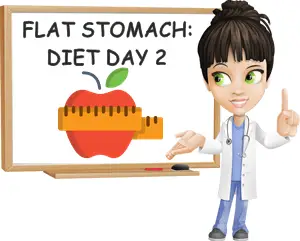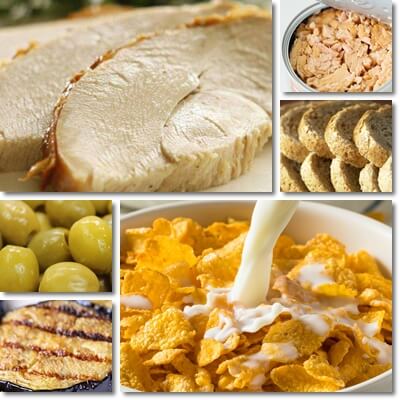If you are looking to get a flat stomach, then you are also looking to lose weight. And losing weight is 80% what you eat.
Weight loss is simply eating lower calorie than you usually do. But for a diet to be sustainable long enough for you to reach your goal, it needs to curb hunger and cravings, and keep you satiated and nourished, and that means getting your macronutrients balanced.
You can eat carbs, protein and a little fat at every single meal and lose weight and all the while drop excess tummy fat. Because getting all your macronutrients is what helps keep you satiated, energized and mentally satisfied, preventing cravings, sugar crashes, binge eating and the mental wear of dieting. To help get you inspired to lose weight and get a flat stomach, see my day 1 flat stomach diet plan followed by my day 2 flat stomach diet plan below.

Day 2 flat stomach diet
Breakfast: corn flakes with milk
- Ingredients: 50 grams of corn flakes, no added sugar, 300 ml low-fat 1% or 1.5% dairy milk or a quality plant milk
- Calories (average values): 192 kcal (kilocalories) from the corn flakes, 132 kcal from the dairy milk for a total of 324 kcal (toppings not included)
- Toppings (optional): for added nutrition and flavor, you can add a small amount of a topping of your choice (each topping provides 50 to 150 extra calories)
Healthy toppings (choose one):
- Topping no. 1: 1 tablespoon of raw honey/maple syrup (if you are not allergic) – 1 tablespoon of honey at an estimated 20 grams provides anywhere between 75 and 100+ kcal (kilocalories)
- Topping no. 2: 15 grams of raw, unsalted and unsweetened nuts of your choice (almonds, walnuts, cashews, Brazil nuts etc.) – 90-100 kcal
- Topping no. 3: 1 medium sized banana at an estimated weight of 140 grams – 125 kcal
- Topping no. 4: 150 grams of strawberries – 50 kcal
- Topping no. 5: 100 grams of blueberries or raspberries – 55-60 kcal
- Topping no. 6: 1 tablespoon of peanut butter – 1 tablespoon of peanut butter at an estimated 25 grams provides 150 kcal on average
- Topping no. 7: 20 grams of dark chocolate with 70% to 80% cocoa solids – 130 kcal
Corn flakes represent the carbohydrate portion of the meal providing both simple and complex carbohydrates, and a little dietary fiber. The mix of simple and complex carbohydrates is a source of both quick energy and energy that dispenses over several hours. Eating corn flakes in the morning boosts energy levels and maintains energy levels elevated from breakfast up until close to lunch time, helping keep you satiated and curbing cravings and sugar crashes that could lead to binge eating.

Pairing corn flakes with milk, even low-fat options, is a good way to enjoy macronutrient balance as milk provides protein and a little fat in addition to carbohydrates. A serving of 300 ml of 1% dairy milk will get you around 10.5 grams of quality protein and close to 3 grams of fat. Add another 3 grams of protein from the corn flakes and you end up with 13.5 grams of protein total for breakfast. That is, without any toppings.
If you add 1 tablespoon of peanut butter (25 grams) you will be getting an extra 5 grams of protein on average, upping your intake to 18.5 grams of protein which is 37% of the entire recommended daily protein intake for the average adult.
Protein is satiating and helps with blood sugar control, preventing highs and lows and associated cravings. Not just this, but protein is needed to maintain muscle mass, as well as gain new muscle, for a higher/faster metabolism that burns more calories.
The milk also helps keep you hydrated and provides small amounts of essential electrolytes to support the cardiovascular function. To boost your fiber intake and enjoy more regular bowel movements, choose fresh fruit as toppings. For mental stimulation and a boost in antioxidants intake, go for dark chocolate.
Lunch: whole grain red rice with canned tuna (in brine) and black or green brined olives
- Ingredients: 60 grams of whole grain red rice, 150 grams light tuna in brine (drained solids), 50 g of brined olives (black or green)
- Calories (average values): 200-215 kcal (kilocalories) from the rice, 135 to 175 kcal for the tuna (canned tuna in brine has 90 to 115 kcal/100 grams), 60 to 75 kcal from the olives (brined olives have 110 to 150 kcal/100 g) for a total of 395 to 465 kcal
- Condiments: salt, pepper, fresh parsley or lovage, chives, other dried herbs and spices you like
Red rice is a type of whole grain rice – in addition to being rich in dietary fiber, it’s also rich in complex carbohydrates to help keep you satiated and satisfied for hours. The red rice not only represents the carbohydrate portion of the meal, but also provides red anthocyanin antioxidants with scientifically proven anticancer and anti-inflammatory properties.
Tuna accounts for the protein part of the meal. Not only is tuna naturally high in protein with a protein content of 22 to 29 grams per 100 grams, but it’s also a source of quality protein, complete with all essential amino acids needed to support muscle function, immune system function and nervous system function.
For the amount specified in the meal, you get 33 to 43.5 grams of high-quality protein, depending on your choice of tuna. That is 66% to 87% of all the protein requirements of the average adult for a day.
Not to mention tuna is a fish high in vitamin D. Find out how much vitamin D in tuna according to type of tuna and how it’s processed/prepared.
The brined olives provide fat, including healthy unsaturated fatty acids such as Omega-3 fatty acids, as well as dietary fiber, completing the macronutrient profile of the meal. A serving of 50 grams of olives can easily add 5-6 grams of fat to the meal.
But if olives are something you just can’t eat, you can substitute them with 100 grams of non GMO sweet corn at around 100 kcal. Alternatively, you can use 100 grams of cooked green peas or 75 grams of canned chickpeas that you can roast in the oven or toast in a pan (with salt, pepper, paprika, turmeric etc.) for a more pleasant texture. While the corn get your carbohydrates and dietary fiber, the peas and chickpeas add substantial amounts of protein as well as fiber to the meal. In any case, you are getting your fat portion of the meal from tuna, so you are still balancing your macronutrients.
Snack:
- Option no. 1: 1 slice of fresh bread or toast (40 grams) with 1 tablespoon (25 grams) of peanut butter, almond butter or pistachio butter (approximately 250 kcal)
- Option no. 2: 1 medium green apple stewed in a little water with a sprinkle of cinnamon (approximately 120 kcal)
- Option no. 3: 200 grams fresh strawberries (approximately 66-70 kcal)
- Option no. 4: 1 small banana (90 grams) with 30 grams dried cranberries (approximately 170 kcal)
A snack is just as important for curbing hunger as it is for curbing cravings. While you do need to limit the number of calories, do eat things you like.
Dinner:
- Ingredients: 200 grams of grilled or pan cooked turkey breast (lean only, no skin), 200 grams of grilled eggplant, 1 tablespoon of olive oil for the eggplants, 2 slices of bread (40 grams)
- Calories (average values): 228 kcal from the turkey breast, 50 kcal from the eggplants, 155 kcal from the potatoes, 125 kcal for the olive oil, 100 kcal from the bread for a total of 503 kcal
The turkey breast is both satiating and light (it’s considered white meat) and packs lots of quality protein, rich in all essential amino acids. Eating turkey at dinner time will not only keep the meal light and prevent acid reflux, especially the way it’s cooked, and also help with sleep due to the amino acids in the meat.
To pan fry turkey breast, choose a piece that is not too thin, heat a nonstick pan over low heat for 2-3 minutes, then place the turkey breast in the pan and cover with a lid. Cook covered for 4-6 minutes over medium low heat, then turn and cook on the other side. The turkey meat will get a nice sear on the sides but stay moist and tender on the inside thanks to being cooked over medium low heat and covered.
The bread accounts for the carbohydrate part of the meal and contributes to satiation, helping you feel satisfied with the meal and not wanting to supplement with extra food. The eggplants provide carbohydrates for macronutrient balance, including dietary fiber for good transit and satiation, and are filling, but poor in calories at the same time. You can season them with salt, pepper, paprika, herbs like parsley, lovage or dill, garlic etc.
If eggplants are not something you like to eat at all, you can always have fresh tomatoes – 250 grams of tomatoes will only get you t0 calories. Or go with 250 grams of champignon or portobello mushrooms that you can also grill and will taste amazing.
